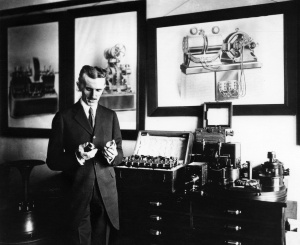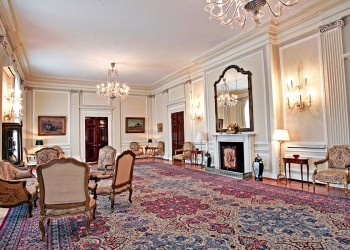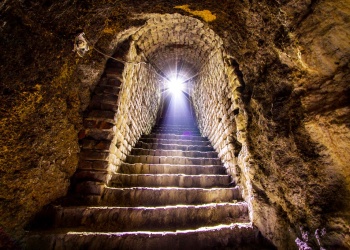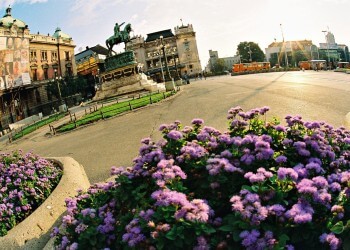Belgrade can be proud of its rich museum collections. Those available for the public represent priceless “windows” into the past and an “educative doors” toward new artistic tendencies. With diverse collections of paintings and objects from prehistoric times until today, Tesla’s inventions, interesting old cars, and other exhibitions, visitors can really get insight into cultural and scientific treasures kept in Belgrade and Serbia.
A visit to the museums of Belgrade represents a walk through entire epochs, providing a view of the rise of a city and its transformation through time and circumstance.
National Museum
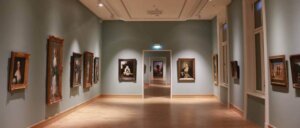
Narodni muzej u Beogradu
National Museum founded in 1844., is the oldest and the most important cultural facility in Serbia. The National Museum in Belgrade is a museum of a complex type dedicated to the protection, interpretation, and promotion of the multicultural heritage of the central Balkans and Europe – culture from prehistory to the present day – through archaeological, numismatic, and artistic material.
The museum collects, preserves, and protects on the basis of the principles of preventive protection and improves knowledge. The most impressive is the collection of artworks of Serbian painters of the 18th and 19th centuries, as well as medieval painters from Europe and China.
The collection of French painters is among the most valuable in the world and comprises of rare works of Matisse, Picasso, Renoir, Rouault, Degas, Cézanne, and others. Museum also holds a collection of Erih Slomović, a Croatian Jew who was murdered in WWII. This valuable collection consists predominantly of impressionist paintings and stands as the largest and richest collection of French art in the Balkans.
The National Museum is located in the center of Belgrade, on the main city square called ’’Trg Republike’’ or Republic Square and it is easily reachable. It’s open for visits every day, except Mondays.
The Museum of Vuk and Dositej
The Museum of Vuk and Dositej is a memorial museum dedicated to two great people of Serbian culture: Dositej Obradović, a member of the Enlightenment Movement and first Serbian Minister of Education, and Vuk Karadžić, the reformer of the Serbian language and creator of Serbian literary language.
The Museum of Vuk and Dositej is located in Dorćol, one of the most beautiful and oldest parts of Belgrade.
Nikola Tesla Museum
Nikola Tesla Museum is a unique institution of science and culture in Serbia and in the world. It is the only museum in the world that preserves the original and personal inheritance of Nikola Tesla.
Nikola Tesla, a scientist of Serbian origin, gave his greatest contribution to the scientific and technological progress of the world as the inventor of the rotating magnetic field and of the complete system of production and distribution of electrical energy based on the use of alternate currents.
Dive into the magical world of Nikola Tesla in the permanent museum collection created by dr Branimir Jovanović. See Tesla’s development as an inventor and as a person through a mix of modern and authentic technologies from the time of Nikola Tesla. Specially trained museum guides will present to you the magnificent working models of Tesla’s machines, his various personal items, and his visions of the future.
The Nikola Tesla Museum is located in Vračar, in Belgrade. Getting to the museum is very easy and it’s open for visitors on every day, except Monday, from 12:00 to 17:00.
Museum of Applied Art
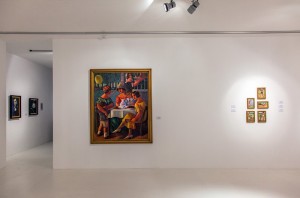 The Museum of Applied Art, founded in 1950, is specialized in the collection, protection, studying, exhibiting, and publishing of works of applied art. Museum collections consist of more than 32.000 objects made by Serbian and international artists. Among the most valuable is one made by artist Ljuba Ivanović that comprises 3.000 artifacts that include jewelry, manuscripts, and printed books, objects carved in wood, horn, mother-of-pearl, woodcut and painted icons, etc. Besides permanent exhibitions, the museum organizes temporary shows and involves various cultural events like the Salon of Architecture, the Children’s Salon of Applied Art, the Salon of Contemporary Applied Art, and the Triennial of Ceramics.
The Museum of Applied Art, founded in 1950, is specialized in the collection, protection, studying, exhibiting, and publishing of works of applied art. Museum collections consist of more than 32.000 objects made by Serbian and international artists. Among the most valuable is one made by artist Ljuba Ivanović that comprises 3.000 artifacts that include jewelry, manuscripts, and printed books, objects carved in wood, horn, mother-of-pearl, woodcut and painted icons, etc. Besides permanent exhibitions, the museum organizes temporary shows and involves various cultural events like the Salon of Architecture, the Children’s Salon of Applied Art, the Salon of Contemporary Applied Art, and the Triennial of Ceramics.
Museum of Contemporary Art Belgrade
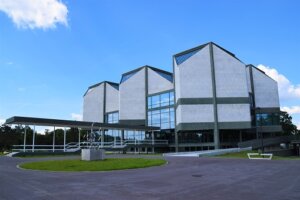 The Belgrade Museum of Contemporary Art was opened on October 20th, 1965. However, Museum activities began as early as 1958, when an act brought by the Cultural Council of the People’s Committee of Belgrade established the Modern Gallery, an institution the purpose of which was to supervise the development of contemporary art in Yugoslavia.
The Belgrade Museum of Contemporary Art was opened on October 20th, 1965. However, Museum activities began as early as 1958, when an act brought by the Cultural Council of the People’s Committee of Belgrade established the Modern Gallery, an institution the purpose of which was to supervise the development of contemporary art in Yugoslavia.
Museum’s founder and its first director were Miodrag B. Protić, a painter and the author of many significant exhibitions, books, and texts concerning the history of modern Yugoslav and Serbian art.
The Building of the Museum of Contemporary Art is situated in New Belgrade, on the left bank of the Sava River, just across the Belgrade Fortress. Its unique concept of interior design and, on the other hand, its link to the surroundings represent an original solution that meets basic museological requirements. The building is an interesting example of museum architecture worldwide. It is surrounded by a sculpture park with works by the most significant Yugoslav sculptors of the 20th century.
The collection of the Museum of Contemporary Art began to form around the time of the establishment of the Modern Gallery and by the time of the opening of the Museum, it counted 3.500 works of art. Today the fund consists of 8.000 works and represents the most relevant collection of art from the Yugoslav art space. Today, the policy of the Museum of Contemporary Art is based on the observation of contemporary art in Serbia, the Balkan region, and in Europe, and worldwide.
Museum of Yugoslavia
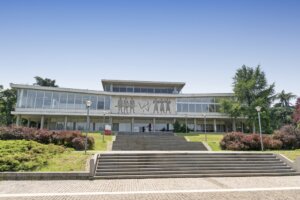 The Museum of Yugoslavia is an open institution that encourages different actors to actively perceive the present through a modern interpretation of the past.
The Museum of Yugoslavia is an open institution that encourages different actors to actively perceive the present through a modern interpretation of the past.
The mission of the Museum of Yugoslavia is to be a place of open dialogue, to exchange knowledge and experiences on the social and cultural phenomena of the 20th century with all institutions, organizations, and individuals interested in issues on Yugoslav heritage and the Yugoslav past. Through programs and activities, the museum encourages social memory and a culture of remembrance related to the development of the Yugoslav idea, since the creation of the Yugoslav state as a kingdom, until its breakup in the early 1990s.
An important part of the Museum of Yugoslavia is the Memorial center of Josip Broz Tito – ”House of flowers”, which is the resting place of former Yugoslav president Josip Broz Tito and his wife.
The Mausoleum is a greenhouse representing a time and ideology that ruled the region for almost 50 years. While visiting House of Flowers you can see collections of Tito’s army uniforms and batons used to transfer birthday greetings from all parts of Yugoslavia.
Residence of Princess Ljubica
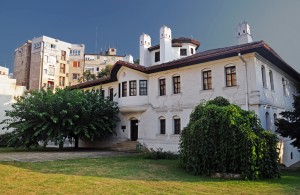 The residence of Princess Ljubica dates from the first half of the 19th century and it used to belong to the family of Prince Miloš Obrenović. It was built in 1831 and represents a combination of the Turkish and European styles of building. It was initially intended for Miloš Obrenović, but because of the proximity of the Turks, who still occupied Kalemegdan Fort, he moved to another residence near Belgrade. However, his wife Ljubica lived here with their children. Today, the Residence of Princess Ljubica is an exhibition space with permanent and temporary exhibitions in the basement of the Residence.
The residence of Princess Ljubica dates from the first half of the 19th century and it used to belong to the family of Prince Miloš Obrenović. It was built in 1831 and represents a combination of the Turkish and European styles of building. It was initially intended for Miloš Obrenović, but because of the proximity of the Turks, who still occupied Kalemegdan Fort, he moved to another residence near Belgrade. However, his wife Ljubica lived here with their children. Today, the Residence of Princess Ljubica is an exhibition space with permanent and temporary exhibitions in the basement of the Residence.
Every Friday at 17:00 and Saturday at 12:00, visitors can experience a special show called “A coffee with Princess Ljubica” (for the tour in English, make an appointment). Nataša Popovska, curator of Belgrade City Museum, dresses as Princess Ljubica, greets guests and tells stories about the Residence. Visitors are offered strong, black coffee and Turkish delights.
Military Museum
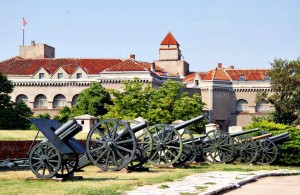
Military Museum, founded in 1878, lies within the walls of Kalemegdan Fortress, invisible to the eye of the visitors until you climb the stairs to its entrance. Surrounded by fortress ramparts and the most beautiful Belgrade Park – Kalemegdan, Museum represents one of the symbols of the Belgrade Fortress.
It was founded by the Decree of Prince Milan Obrenović IV on August 22nd, 1878. It was yet another manifestation of celebrating Serbia’s Independence. During WWI and WWII collections suffered major devastations or were seized by occupation troops.
In new conditions, after WWII, new work on collecting objects started, especially from the previous war. Also, an adaptation of Display began in accordance with the new ideology. Museum collections were significantly enriched, especially with objects from War and Revolution, and Military Museum became an essential institution of the new country.
The Military Museum today has a large collection dating from prehistory to nowadays wars: arms, uniforms, flags, decorations, maps, models, dioramas, and photographs. Next to the museum is an open-air exposition of tanks and artillery pieces, torpedo boats, and underwater mines.
Ethnographic Museum
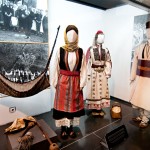 Ethnographic Museum is one of the oldest cultural institutions in Belgrade since it exists for more than one hundred years. It displays a valuable collection of objects, clothes, and furniture, which teach more about the way of life of people from the region of the Balkans. The collection is made of 160.000 objects from the lives of both rural and urban populations. It has a very attractive souvenir shop, from which we recommend replicas of Serbian medieval jewelry.
Ethnographic Museum is one of the oldest cultural institutions in Belgrade since it exists for more than one hundred years. It displays a valuable collection of objects, clothes, and furniture, which teach more about the way of life of people from the region of the Balkans. The collection is made of 160.000 objects from the lives of both rural and urban populations. It has a very attractive souvenir shop, from which we recommend replicas of Serbian medieval jewelry.
Historical Museum of Serbia
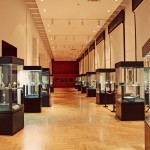 In the beginning, the Historical Museum of Serbia had several collections divided into different sections (historical, written documents, paintings, graphics and sculpture, weapons, and ethnology). After the new concept was adopted, the exhibition was changed into a more universal presentation of a rich and colorful history of the Serbian people and stands like that until today.
In the beginning, the Historical Museum of Serbia had several collections divided into different sections (historical, written documents, paintings, graphics and sculpture, weapons, and ethnology). After the new concept was adopted, the exhibition was changed into a more universal presentation of a rich and colorful history of the Serbian people and stands like that until today.
Museum of Serbian Orthodox Church
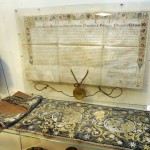 The Museum of the Serbian Orthodox Church presents more than three hundred artifacts, however, in the museum storage there are several thousand more. The museum display includes historical, ecclesiastical, and artistic treasures: objects from the monasteries (including the inheritance before the Great Migration of 1690), and from the churches of the eastern Srem that were returned from Zagreb, where they were taken during the Second World War.
The Museum of the Serbian Orthodox Church presents more than three hundred artifacts, however, in the museum storage there are several thousand more. The museum display includes historical, ecclesiastical, and artistic treasures: objects from the monasteries (including the inheritance before the Great Migration of 1690), and from the churches of the eastern Srem that were returned from Zagreb, where they were taken during the Second World War.
Museum of Aviation
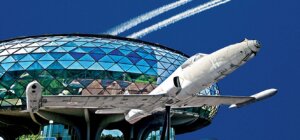
Visitors approaching the Nikola Tesla Airport are invariably attracted by the large glass-encased round structure. Numerous military and civilian aircraft surrounding the building – along with radars and other wonders of aviation technology – clearly indicate to visitors that they have arrived at an Aviation Museum.
It was founded in 1957. and it has a collection of airplanes mostly displayed in the building. However, a squadron of Yugoslav-made fighters, larger civil airplanes, and helicopters surround the ground around the Museum. The collection includes parts of airplanes shot down during the NATO bombing (the popular ’’invisible’’ F-117), cruise missiles, and the unique FIAT G-50 fighter airplane.
The Museum’s storerooms and its library contain thousands of books, objects, and documents about the expansion of aviation in our country and internationally. It is no wonder that many foreign experts who have had the opportunity to gain a better understanding of its valuable exhibits have declared that the Aviation Museum in Belgrade is a true treasury of aviation history.
The rich collections of Belgrade museums were created during the 19th and 20th centuries. Private collections of wealthy families make up a considerable part of the treasures kept in the museums of Belgrade today.
There are many more museums in Belgrade that are not listed above, but we recommend looking into them also, like the Museum of Paja Jovanović, Jewish Historical Museum, Museum of Roma Culture, Museum of Yugoslav Film Archive, Gallery of Frescoes, Car Museum, FC Red Star Museum and many more.
